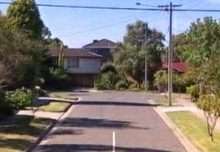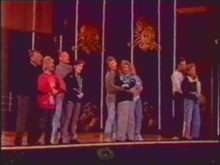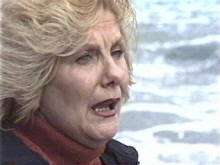|
.
Interviews
> Peter Pinne
Peter
Pinne was Executive in Charge of Production on Neighbours
from the late 1980s until 1992, although his involvement stretched
back further - to the setting-up of the original series on
Channel 7 in 1985. In this insightful interview, Peter recalls
the time he spent with the show, and reveals himself to be
behind one of Neighbours’ most infamous scenes..
Can
you give us a background on your career and involvement in
the television industry prior to Neighbours?
I had worked as a writer and script editor on many serial
productions including The Young Doctors, The Restless
Years and Sons and Daughters. In 1980 I became
Head of Production for Grundy Television and in that capacity
was responsible for all drama production that the company
made. This included serials, series, tele-movies and documentaries.
 |
Can
you explain to us your various roles in the production of
the Neighbours saga through the years?
When the concept of the show was sold to Channel 7 it was
my job to set-up the production. I organised a location scout
to find suitable locations for the show in Melbourne, one
of which was Pin Oak Court. I showed a selection of these
locations to Ian Holmes, who was President of the company
and it was his decision to go with Pin Oak Court. I then went
around to every house in the street securing permission to
use the exterior of their houses for the series. It was also
my job to find the Producers and directors for the show, plus
the storylining team. We initially filled these roles from
within the organization but as the show went on we had to
search outside the company to fill these positions. Reg Watson,
the Executive Producer, had casting and storyline approval
of everything in the beginning. Later, in the late eighties,
I became Executive in Charge of Production for the series
and was responsible, along with Don Battye, for the direction
the show took.
Was
there a feeling in Grundys at the time of the show’s debut
in 1985 that the company had struck gold with this series?
By the time Neighbours started on air I believe everybody
had an idea that this was a serial that was different. Its
use of comedy in each episode set it apart from any other
serial on air at the time.
What
do you think went wrong for Neighbours on Channel 7?
The wrong timeslot was the main reason. Channel 7 had commissioned
a show for the 7p.m timeslot, and then they played it much
earlier. It didn’t work.
How
did the unprecedented move to Network Ten come about?
When the show didn’t deliver the ratings that Channel 7 wanted
they cancelled the series. Ian Holmes in an unprecedented
move then took the show to Network 10 who picked it up. At
that time there was no legal impediment in the Channel 7 contract
to prevent Grundy from taking the show to another channel.
Now, every serial that is made in Australia has a clause to
prevent this happening again. Channel 7 refused to sell the
set to Network 10 who were willing to buy it. They chose instead
to destroy it. Therefore every interior set had to be recreated
again in the Network 10 studios.
A
number of changes were made to the series on Ten - how important
do you think these changes were to the show’s eventual success
on Ten?
The most important changes were the introduction of Madge
(Anne Charleston) and the recasting of Scott. Darius Perkins,
the original Scott, who was the son of the original set designer
Robbie Perkins, was unreliable and Jason Donovan proved to
be a much better actor in the role.
What
do you think were the reasons for the ‘Neighbours Mania’ that
engulfed countries across the world - particularly the UK
- in the late 1980s?
Neighbours was successful in many countries but ‘Neighbours
Mania’ only ever happened in the UK. The main reason the show
took off there was that it was light relief to the British
serials who were going through a major period of doom and
gloom. Neighbours with its comedy, sunshine, and attractive
people, were an instant turn-on to the UK audience.
 |
As
a testament to the show’s massive success in the UK at that
time, the cast appeared before the Queen Mother and Princess
Margaret at the 1988 Royal Variety Show. Having accompanied
the cast to London for the performance, can you tell us about
the experience? How did you go about selecting which cast
members should attend?
The BBC wanted the cast to appear at the Royal Performance
at the London Palladium but in order for them to do so production
had to be stopped for one week. This was difficult because
we were very tight to air and really could not afford to lose
one week’s production. Eventually a deal was worked out between
the BBC, Network 10 and Grundy which cleared the way for the
cast to go. The BBC wanted all members of the major cast to
appear and that’s who went. The Royal Performance show included
all the cast members of the U.S. series The Golden Girls,
the cast of the UK series Bread, Ann Miller, Mickey
Rooney, Cliff Richard, Jackie Mason, Julio Iglesias, Bananarama,
Rick Astley, A-Ha, Michael Feinstein, Bruce Forsyth, and Ronnie
Corbett amongst others. Kylie Minogue appeared as a solo performer
refusing to appear with the rest of cast. She had left the
series by that time and wanted to distance herself from the
show. The Neighbours cast did a very ordinary sketch
(written by the BBC) and sang the theme song to the show.
While the cast were in town they were also invited, along
with all of the other Royal Performance artists, to a lunch
given by the Variety Club.
 |
What
factors led you to kill of characters such as Daphne, Kerry,
Harold, Todd etc as opposed to sending them off to Brisbane
like many of the other characters?
It is always a major decision to kill off a character in a
serial and one not to be taken lightly. The storyliners usually
agonise over it for weeks. That was why Harold was never killed.
We had run out of stories for Madge and Harold and we had
to get rid of one of the characters. We thought we could get
more mileage out of Madge solo so we decided to have Harold
disappear. We didn’t want to kill him nor did we want them
to divorce. Having him washed out to sea was the best solution
to a difficult decision.
How
important do you think the core, long serving characters such
as Helen, Jim, Paul, Madge etc, were to Neighbours?
There would be no long-standing series without core characters.
The audience identify with them and want to watch their lives.
When
hugely popular characters such as Charlene, Scott and Henry
left the series, did you think their exits would effect the
show’s popularity?
People watch a serial because of the show, not because of
one particular character. Any serial can lose a number of
core characters and still survive.
Mrs.
Mangel’s departure was a huge loss to the series in that Ramsay
Street lost its nosey neighbour. Were characters like Edith
Chubb and Hilary Robinson introduced to try and fill the void
left by Mrs. Mangel?
Yes, it’s essential to have a black hat in a series. Hilary
wore it for a time in Neighbours. So did Dorothy (Maggie
Dence).
Who
were your favourite characters, and why?
I liked them all. They were a good ensemble cast.
Did
you have any favourite storylines? And were there ever any
storylines that you didn’t like?
Some storylines I liked and some I didn’t but that happens
no matter what serial you are working on.
How
much of a direct input did you have on the storylining process?
Where there ever any storylines that you came up with?
In the early days I would often sit in on a storylining meeting
and offer suggestions as to where we could go with a story/character.
Later when I became Executive in Charge of Production for
the show I did it weekly and had direct input as to what went
on air. Jason Daniel reminded me recently that he has never
forgiven me for making them do Bouncer’s Dream which was my
idea. Of course it was a silly idea but it got covers in all
the TV magazines and rated.
What
led to your decision to leave Neighbours? Where has
your career taken you since then?
The company asked me to go to Los Angeles to set-up and be
Executive Producer of Dangerous Women, a spin-off of
Prisoner, which was Grundy’s first serial to be produced
in the U.S. We made 52 one hour episodes. During this period
I also oversaw the launch of Neighbours in the U.S.
It didn’t work, mainly because of the Australian accent. You
must remember this was in a time when even movies like Crocodile
Dundee were dubbed for the American market. Following
Dangerous Women, I became Vice President Drama for
Grundy Worldwide, and later went to South America where I
set-up companies in most Latin American capitals and made
television programs, everything from game shows to sitcoms.
In Chile I made a Chilean version of Mother and Son.
I left television four years ago and set-up my own recording
company in the U.S. which is called Bayview and I now record
music around the world, mostly in New York.
Have
you watched Neighbours in the years since you left?
As I have been living abroad since the early 90s I have not
seen the show.
What
did you most enjoy about your involvement in the Neighbours
saga?
I enjoyed the fact that an Australian production could be
so successful internationally and at its peak in the UK was
watched by 20 million viewers.
What
do you think accounts for the huge success Neighbours
has achieved over the past 18/19 years?
It is about ordinary people. No matter what country we live
in or what nationality or religion we are, we are basically
all the same and we like watching the stories of other people.
It’s as simple as that.
Interview by Moe. Added on 21st December 2003
Back
|

